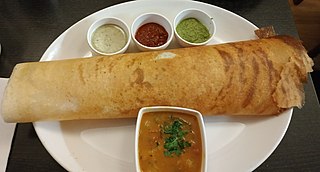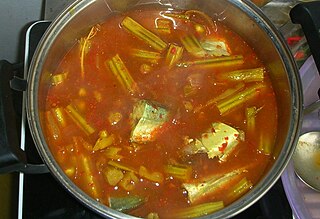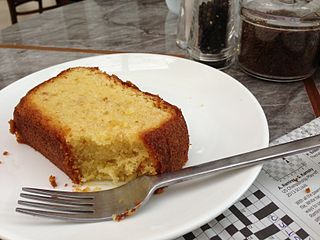This is a list of culinary vegetables used in the cuisine of Assam.
| Assamese name | English name | Scientific name | Image | |||
|---|---|---|---|---|---|---|
| Mosur-Maah | Lentil | Lens culinaris | | |||
| Motor-Maah | Pea | Pisum sativum | | |||
| Dhua Mogu | White lentil | Vigna mungo | | |||
| Mati-Maah | Urad bean | Vigna mungo | | |||
| Mogu-Maah | Mung bean | Vigna radiata | | |||
| Rohor dail/dali | Pigeon pea | Cajanus cajan | | |||
| Boot-Maah | Chickpea | Cicer arietinum | | |||
| Motor Dail/Dali | Split pea | Pisum sativum | | |||
| French bean | Green bean | | ||||
| Runner bean | Phaseolus coccineus |  | ||||
| Dangbodi/Lesera/Leseri | Yardlong bean | Vigna unguiculata sesquipedalis |  | |||
| Raz-Maah | Common bean | Phaseolus vulgaris | | |||
| Lesera-Maah | Black-eyed pea | Vigna unguiculata unguiculata | | |||
| Urohi | Indian Bean | Lablab purpureus |  | long guti | clove Bean | Ipomoea Muricata |
| Assamese name | English name | Scientific name | Image |
|---|---|---|---|
| Aada | Ginger | Zingiber officinale | |
| Nohoru | Garlic | Allium sativum | |
| Piyaaj | Onion | Allium cepa | |
| Jeera | Cumin | Cuminum cyminum | |
| Kaal Jeera, Kola Jeera | Black cumin | Nigella sativa | |
| Jaluk | Black pepper | Piper nigrum | |
| Jolokiya | Chili pepper | | |
| Halodhi | Turmeric | Curcuma longa |  |
| Dhoniya | Coriander seed | Coriandrum sativum | |
| Dalsini, Dalseni | Cinnamon | Cinnamomum verum | |
| Elaisi, Elaichi | Cardamom | Elettaria cardamomum | |
| Lwong | Clove | Syzygium aromaticum | |
| Methiguti | Fenugreek seed | Trigonella foenum-graecum | |
| Boga Xoriyoh | White mustard seed | Sinapis alba | |
| Sofguti | Fennel | Foeniculum vulgare |  |
| Tezpat | Bay leaf | Cinnamomum tamala | |
Indian cuisine consists of a variety of regional and traditional cuisines native to the Indian subcontinent. Given the diversity in soil, climate, culture, ethnic groups, and occupations, these cuisines vary substantially and use locally available spices, herbs, vegetables, and fruits.

A samosa from the Persian word Sambosag (سنبوسگ) is a fried South Asian and West Asian snack. It is a pastry with a savory filling, mostly vegetables, spiced potatoes, onions, peas, also meat, or fish. It is made into different shapes, including triangular, cone, or crescent, depending on the region. Samosas are often accompanied by chutney, and have origins in medieval times or earlier. Sweet versions are also made. Samosas are a popular entrée, appetizer, or snack in the cuisines of India, South Asia, West Asia, Central Asia, East Africa and their South Asian diasporas.

Sambar is a lentil-based vegetable stew, cooked with pigeon pea and tamarind broth. It originates in South Indian cuisine and is popular in large parts of India and beyond.

Assamese cuisine is the cuisine of the Indian state of Assam. It is a style of cooking that is a confluence of cooking habits of the hills that favour fermentation and drying as forms of preservation and those from the plains that provide extremely wide variety of fresh vegetables and greens, and an abundance of fish and meat. Both are centred on the main ingredient — rice. It is a mixture of different indigenous styles with considerable regional variations and some external influences. The traditional way of cooking and the cuisine of Assam is very similar to South-East Asian countries such as Thailand, Burma (Myanmar) and others. The cuisine is characterized by very little use of spices, little cooking over fire, and strong flavours due mainly to the use of endemic exotic fruits and vegetables that are either fresh, dried or fermented. Fish is widely used, and birds like duck, pigeon, squab, etc. are very popular, which are often paired with a main vegetable or ingredient; beef used to be eaten before British colonialism, and some continue to do so. Preparations are rarely elaborate. The practice of bhuna, the gentle frying of spices before the addition of the main ingredients so common in Indian cooking, is absent in the cuisine of Assam. The preferred oil for cooking is the pungent mustard oil.

Parkia speciosa, the bitter bean, twisted cluster bean, sator bean, stink bean, or petai is a plant of the genus Parkia in the family Fabaceae. It bears long, flat edible beans with bright green seeds the size and shape of plump almonds which have a rather peculiar smell, similar to, but stronger than that of the shiitake mushroom, due to sulfur-containing compounds also found in shiitake, truffles and cabbage.

In cooking and gastronomy, duck or duckling is the meat of several species of bird in the family Anatidae, found in both fresh and salt water. Duck is eaten in many cuisines around the world. It is a high-fat, high-protein meat rich in iron. Duckling nominally comes from a juvenile animal, but may be simply a menu name.

Peranakan cuisine or Nyonya cuisine comes from the Peranakans, descendants of early Chinese migrants who settled in Penang, Malacca, Singapore and Indonesia, inter-marrying with local Malays. In Baba Malay, a female Peranakan is known as a nonya, and a male Peranakan is known as a baba. The cuisine combines Chinese, Malay, Javanese, South Indian, and other influences.

Indian breads are a wide variety of flatbreads and crêpes which are an integral part of Indian cuisine. Their variation reflects the diversity of Indian culture and food habits.

Beguni is a common Bengali snack. It is made of eggplant which is sliced and dipped in gram flour batter before being either fried or deep fried in oil.This dish is also popular in eastern Indian states of West Bengal,Assam and Tripura. A similar European dish is known as aubergine fritters.

Pakhaḷa is an Odia cuisine, consisting of cooked rice washed or lightly fermented in water. The liquid part of the dish is known as Toraṇi. It is popular in the state of Odisha and its similar in the eastern regions like Jharkhand the northeastern states of Assam.

In West Bengal, Tripura, Odisha, Assam and Bangladesh, fried fish or māchh bhājā is a common delicacy. Riverine fish like bhetki, topshey, aarh and pābdā, and anadromous fish such as hilsa are commonly fried in Bengali cuisine, Odia cuisine and Assamese cuisine.
Khardwi is an alkaline liquid used in the cuisine of the Bodo people. It is produced as the filtrate of ash powder formed through burning dried banana stems, bamboo, coconut coirs or even potato plants. It tastes like strong soda and used in small quantities as an ingredient in gravy. Khardwi is a common favorite drink in Bodoland, Assam especially among the Bodos. Khardwi is one of the important part of the Bodo cuisines. It is use in making Bodo curries like lafa kharwi, mwitha bangal kharwi, sojona bilai kharwi and many other green leaf kharwi. It is also used to make some curry like onla, sobai kharwi, etc.

Eryngium foetidum is a tropical perennial herb in the family Apiaceae. Common names include culantro (Panama), cimarrón,recao, chardon béni (France), Mexican coriander, samat, bandhaniya, long coriander, Burmese coriander, sawtooth coriander, and ngò gai (Vietnam). It is native to Mexico, the Caribbean, and Central and South America, but is cultivated worldwide, mostly in the tropics as a perennial, but sometimes in temperate climates as an annual.

Chulesi, Boti, dao, da, aruvamanai, chulesi, pavshi, vili, morli or pirdai is a cutting instrument, most prevalent in Nepal, Maharashtra, South India, Bihar, Pakistan and the Bengal region, Bihar, Tripura, the Barak Valley of Assam.

Kaeng som, gaeng som, Asam rebus, or Thai/Lao/Malaysian sour curry is a sour and spicy fish curry or soup with vegetables popular in Southeast Asia. The curry is characteristic for its sour taste, which comes from tamarind (makham). The recipe uses palm sugar to sweeten the curry.

The cuisine of Mauritania includes the culinary practices of Mauritania. Historically, what is now Mauritania has been influenced by Arab, Berbers and African peoples who have lived in and traversed the "stark" landscape marked with Sahara desert dunes in caravans. There is an overlap with Moroccan cuisine in the north and Senegalese cuisine in the south.

The Eurasian cuisine of Singapore and Malaysia is a type of fusion cuisine.